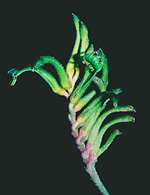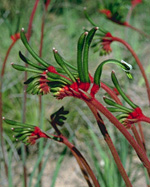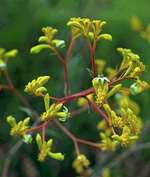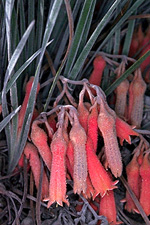 |
This family is most diverse in south-western Western Australia, although some are found along the east coast and in the tropical north. Outside Australia, a few species occur in south-east Asia, South Africa and Central America. They are characteristic of heath communities on nutrient-poor, acid sandplains or sandy seasonal swamps.
Characteristic features of the family Haemodoraceae in Australia include: - perennial, rhizomatous or tuberous herbs, often with red sap in the roots or tubers
- leaves grass-like but tough, linear, usually glabrous
- flowers with 6 perianth parts, these free or fused into a short or long tube, regular or strongly zygomorphic (as in the "kangaroo paws"), white, cream, yellow, red or green
- ovary inferior, developing into a capsular fruit enclosed or surrounded by the dry, persistent perianth
Description
Perennial terrestrial herbs. Perennating by bulbs, tubers or rhizomes. Vegetative reproduction by bulbs, tubers, rhizomes or stolons. Internal secretions not obvious. Plants glabrous or with simple, non-glandular, unicellular hairs. Leaves distichous, or in whorls of 7 or more, all or mostly basal, or both basal and cauline, sessile. Stipule-like lobes absent. Lamina simple, symmetric, filiform, acicular, subulate or linear; margins entire, involute or incurved; venation parallel, with the midrib inconspicuous, and the tertiary venation not reticulate; surfaces not punctate; herbaceous, leathery or succulent. Leaf ligule absent. All the flowers bisexual. Inflorescences terminal, consisting of racemes, panicles, corymbs, umbels, monochasial cymes or solitary flowers, or rarely of capitula. Bracts present or absent. Bracteoles present. Pollination by insects or birds. Flowers odourless or fragrant, stalked. Floral disc absent; nectaries present on the carpels. Perianth of 2 dissimilar whorls or of 1 whorl only or all whorls ±similar, with 6 segments, imbricate or valvate in bud. Calyx regular, often petaloid; segments free, with 3 sepals, herbaceous or succulent. Corolla regular or irregular, rarely sepaloid; segments free or fused, with 3 petals or lobes, alternating with the sepals; corolla curved-tubular, yellow, orange, red, pink, magenta or purple, green, grey, brown or black, without contrasting markings, or streaked, spotted, etc, membranous or succulent; claws absent; lobes ±entire. Fertile stamens 3 or 6, opposite to the sepals, free or at least partly fused to the corolla, free of the ovary and style, distinct from each other, all ±equal. Staminal filaments present or absent. Anthers dorsifixed or basifixed, not versatile, opening inwards by longitudinal slits; 2-celled. Ovary part-inferior or inferior. Carpels 3, fused; ovary with 3 locules. Style terminal, single and unbranched with the stigma capitate. Ovules 2–numerous per locule, stalked or sessile; placentation apical or axile. Fruit a dry, dehiscent loculicidal capsule; the perianth on the maturing fruit deciduous or dry and persistent. Disseminule micro-surface ±reticulate, brown, dull. Seeds 2–numerous per fruit. Aril absent. Cotyledons 1. Embryo round or shapeless.
(Note: this description has been generated from the coded data compiled for the key. Any errors in the key data will be reflected in the descriptions.)
A treatment of the family Haemodoraceae has been published in:
Flora of Australia 45: 55-148.
Australian genera of Haemodoraceae (as recognised for the Flora of Australia)
* = all species introduced
Anigozanthos
Blancoa
Conostylis
Haemodorum
Macropidia
Phlebocarya
Tribonanthes
*Wachendorfia

|
  |

Anigozanthos bicolor (flowers)
Photo: D.Greig © ANBG

Anigozanthos manglesii (flowers)
Photo: D.Greig © ANBG

Anigozanthos pulcherrimus (flowers)
Photo: D.Greig © ANBG

Conostylis canescens (flowers)
Photo: M.Fagg © ANBG

|
 |
|